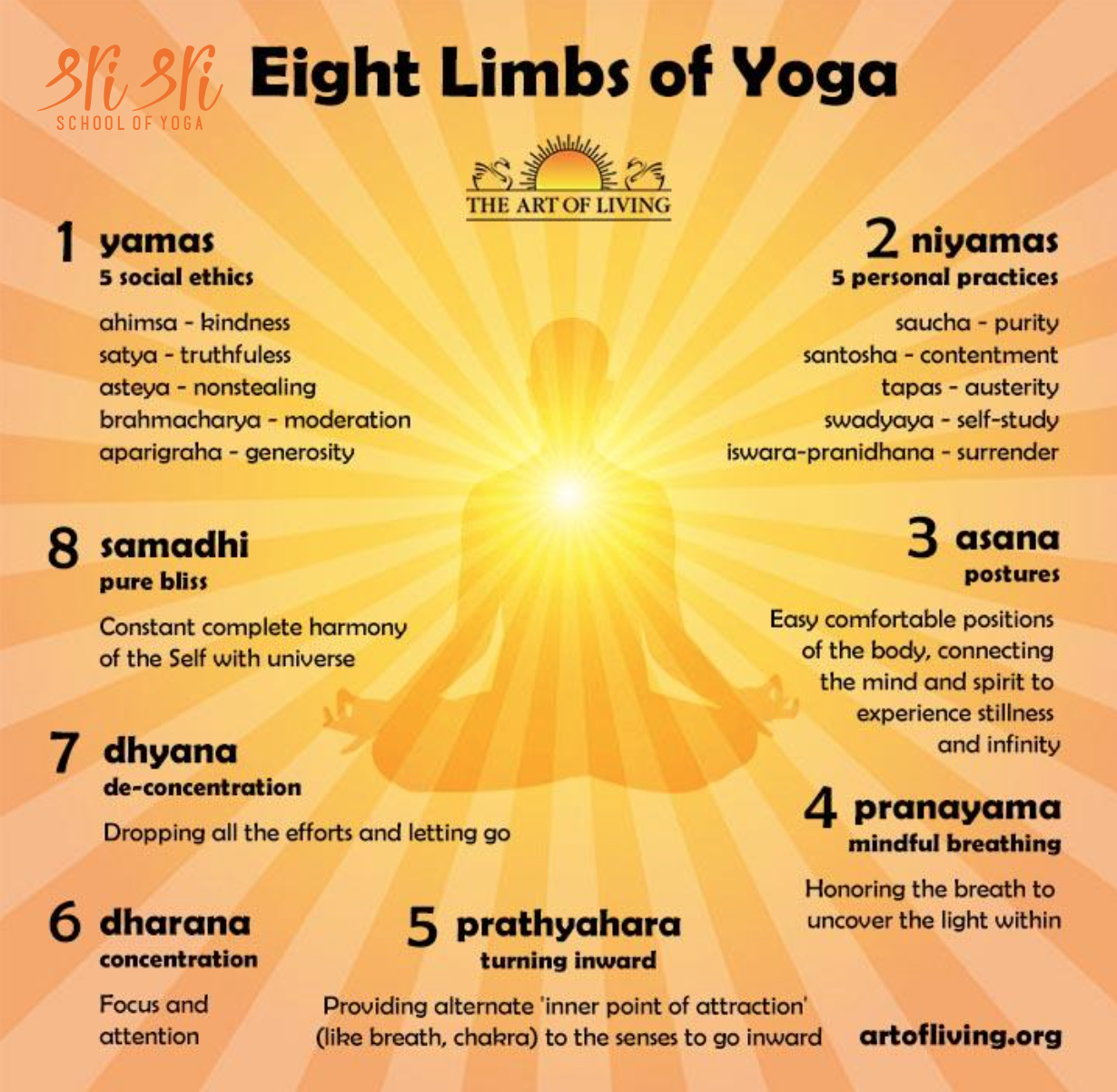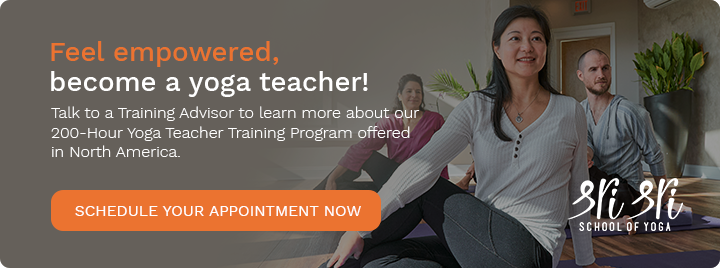Did you know that the eight-fold path of yoga (8 limbs of yoga aka ashtanga yoga) is like the blueprint for the entire lifestyle? Read on to find out.
Yoga is an ancient practice of living that provides a complete philosophy to live a healthy, happy life to its full potential. The origins of yoga can be traced back more than ten thousand years. Among many, The Rig Veda, Patanjali’s Yoga Sutras, and The Bhagavad Gita are three of the most popular ancient texts that offer insights on yoga. They explain profound yogic philosophy and many transformative yoga practices.
What are the eight limbs of yoga?
In 400 CE, Maharishi Patanjali, a sage scientist from India, wrote 196 aphorisms on yoga, popularly known as Maharishi Patanjali’s Yoga Sutra. The word sutra means “to thread or weave” just as the English word suture means “to stitch together.” These sutras are so clear, accurate, full of precious wisdom to prevent, overcome and transcend the human miseries and suffering even in modern times.
The Sutras (or writings) of Patanjali are divided into four sections or padas. The practice of the eight-fold path of yoga comes from section two called the Sadhana Pada. In this chapter, Sage Patanjali mentions this eight-fold path as “ashtanga yoga” in sutra 29 (aphorism 2.29). He created this path to help us transcend human sufferings and to reach self-realization and ultimate freedom. In simple words, this way of living promotes the harmonious collaboration of body, mind, and spirit and complete health and wellbeing.
यमनियमासनप्राणायामप्रत्याहारधारणाध्यानसमाधयोऽष्टावङ्गानि ॥ २.२९॥
“Yama niyama asana pranayama pratyahara dharana dhyana samadhi ashtau angani”. (2.29)
Yama, Niyama, Āsana, Prānāyāma, Pratyāhāra, Dhāranā, Dhyāna, and Samādhi are the eight limbs of Yoga.
Ashta means eight, anga means limbs. These eight limbs are:
- Set of 5 social ethics: Yama
- Set of 5 personal ethics: Niyama
- Poses or Postures: Asana
- Breathing exercises / Breathing techniques/ Breathwork: Pranayama
- Withdrawing the senses inward: Pratyahara
- Art of effortless concentration: Dharana
- Meditation: Dhyana
- Complete harmony with universal consciousness: Samadhi
In Samadhi Pada–the first chapter of yoga sutras, Sage Patanjali defines yoga as:
Yogas chitta vritti nirodhah: Yoga is stilling the fluctuations of the mind. (1.2)
Tada drastuh svarupe vasthanam: Yoga is abiding in the nature of the seer. (1.3)
Thus the 1st chapter clarifies the goal of yoga while the 2nd chapter suggests a path to achieve that goal.
Overview of the 8 limbs of yoga

Social and personal ethics of yoga: yamas and niyamas
Yama and Niyama are the first two limbs of ashtanga yoga. Understanding them will help you learn how to practice yoga in your daily life. This can transform you and your yoga practice.
Yamas are universal morality, attitudes towards society and how you treat others and the world around you. The set of 5 yamas are:
Ahimsa: Non – Violence / Non – Harming / Kindness / Compassion
Satya: Non-Deception / Truthfulness
Asteya: Non-Stealing / Honesty /Abundance
Brahmacharya: Celibacy / Moderation of the Senses / Self – Restraint
Aparigraha: Non-Greed / Security / Self-reliance / Non – possessiveness / Non-accumulating
Niyamas are Personal observances, Attitudes towards ourselves and inner discipline and responsibility. There are 5 Niyamas:
Shoucha: Purity
Santosha: Contentment / Happiness
Tapas: Self – Discipline / Austerity / Penance
Swadhyaya: Self Examination / Self Study
Ishvarapranidhana: Self – surrender to the divine / Spiritual Attunement
For better understanding and how to integrate these in daily living, download our free ebook: Decoding Yamas and Niyamas for the Modern Yogis
Yoga poses: asana
Today, most people practicing yoga focus on the practice of the third limb, Asana, or yoga postures. Yoga poses are a discipline of physical postures designed to purify the body and provide physical stability, stamina, and strength. Many people only know yoga as the practice of physical yoga postures. It is definitely a good starting point. In ancient times, asana practice was meant more for cultivating the physical and mental stability and easiness that is required for the practice of meditation (the seventh limb). The literal meaning of asana is “a seat”.
Asanas include the dual qualities of alertness (steadiness) and relaxation (easeness). Asanas give us an opportunity to study and explore the physical realm of our existence. More than flexibility of muscles and alignments, they are about connecting physical steadiness to stillness and happiness of mind.
Asanas involve increased awareness of various physical and physiological processes influenced by controlled stretching, contraction, relaxation, and coordination of various muscles, and in balancing and maintenance of posture.
At a deeper level, asana means full expression of mind-body integration, in which one becomes consciously aware of the flow of life energy in the body. Performing asanas with awareness is practice for performing every action in life with awareness.
It is believed that there are more than 84,000 different yoga poses. Don’t get intrigued by this huge number! You don’t have to learn that many poses! Just a handful of them will be great. As you progress you may add some more challenging advanced poses.
Breathing practices: pranayama
Pranayama consists of two Sanskrit words—Prana (life force) and Ayama (control). So, pranayama means the regulation of the flow of life force. It is the science of breathing. Breath is the physical expression of life-force energy. In recent years, the term breathwork has been coined to describe breathing exercises or breathing techniques.
We breathe every single minute. We take approximately 21, 600 breaths every day!
Breath is a bridge between our body, mind and spirit. Changes in our mind affect our breathing and vice-versa. Every emotion has a corresponding rhythm of the breath, and the way we breathe can influence the way we feel.
Breathing is also a bridge between our sympathetic and parasympathetic systems.
Practice of pranayama helps us to harness the power of breath for physical, mental, emotional and spiritual health.
Give a try to some simple ones like Breath of Joy, Alternate Nostril Breathing or Ujjayi Breathing.
Breath of Joy
Sense withdrawal: pratyahara
Most of the time we are engaged with the outer world through our senses. Our senses distract us from coming inwards. The various techniques of Pratyahara teach us to withdraw our senses from the outer world. These techniques allow the mind to settle inwards.
Intention and focus: dharana
When the mind settles inwards we can train it to focus effortlessly. Dharana techniques help us in maintaining this inward attention. Get your earphones and try this Dharana to Dhyana Meditation.
Meditation and ultimate bliss: dhyana and samadhi
Meditation or Dhyana is the effortless art of doing nothing in order to experience inner peace. It is the skill of relaxing the mind totally and living in the present moment. Through regular practice of meditation, we can remain in witness consciousness and achieve a blissful state with complete evenness of mind and harmony with the universal consciousness. This is the final limb, Samadhi.
Why should you practice 8 limbs of yoga?
Sage Patanjali explains this in Sutra 29 of the second chapter.
योगाङ्गानुष्ठानादशुद्धिक्षये ज्ञानदीप्तिरा विवेकख्यातेः ॥ २.२८॥
“Yoga anga anushtanat ashuddhi kshaye jnanadi Apthiraviveka khyatehe’’ (2. 28)
“By the sustained practice of the eight limbs of yoga, the impurities are destroyed and the light of wisdom, discrimination shines forth.”
When we move through the eight limbs of yoga as a dynamic whole, the practice starts to reveal our true self. All conflict and duality drops to illuminate the light that we are. As explained by Gurudev Sri Sri Ravi Shankar, “Yoga has eight limbs like a chair which has got four legs. Yoga has eight legs, eight limbs; each one is connected to the whole. So if you pull one, everything else will come. If you pull one leg up, the whole chair comes. When the body is developing, the whole body develops together. Organs develop together. Not that the nose develops first and then the ear comes. Simultaneously all the aspects, all the limbs of the body develop. That is why Patanjali says that these are all the limbs of yoga (not steps of yoga).” This realization is a gift that we unwrap when we start practicing the eight limbs of yoga together.
Want to know more about the sutras and the 8 limbs of yoga?
The Patanjali Yoga Sutra serves as the guidebook for most yoga practitioners today. Gurudev Sri Sri Ravi Shankar has given an extensive commentary on Patanjali’s Yoga Sutras. Studying The Yoga Sutras, especially with a commentary like Gurudev’s, can help you to understand the profound wisdom of yoga with razor sharp clarity and its practical relevance. This commentary is available in book form or on the Art of Living Journey App. The 200H yoga teacher training offered by the Sri Sri School of Yoga also gives a great opportunity to understand the yoga scriptures in greater depth.
Are you interested in becoming a 200-Hour certified yoga teacher?
Sri Sri School of Yoga is a registered school with Yoga Alliance. It offers the most authentic, traditional (scripture-based), and accessible 200-Hour teacher training programs in online, hybrid and in-person set up.


